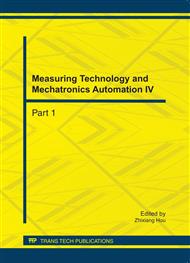p.247
p.251
p.255
p.261
p.265
p.270
p.276
p.280
p.285
Robotic Waist Mechanism Driven by Dielectric Elastomer Actuators
Abstract:
This paper presented a waist mechanism driven by dielectric elastomer actuators (DEA), suitable for a small light robot. Unlike traditionally continuous range-of-motion actuators, DEA have only two discrete states, both of which are stable. As a result, waist mechanism has a finite number of states, but works like human waist and just need 36 switching values to control. Major benefits of the waist mechanism are that extensive feedback control is not required, task repeatability can be very high, and DEA are very inexpensive, thus resulting in low cost robots. The waist mechanism is attractive but needs further investigation before successful application.
Info:
Periodical:
Pages:
265-269
Citation:
Online since:
October 2011
Authors:
Price:
Сopyright:
© 2012 Trans Tech Publications Ltd. All Rights Reserved
Share:
Citation:


